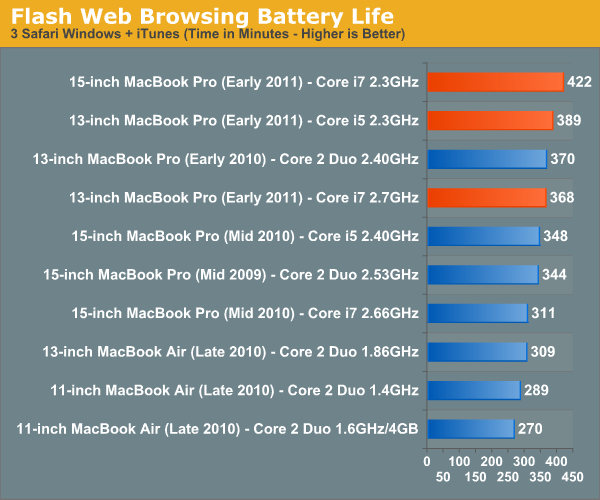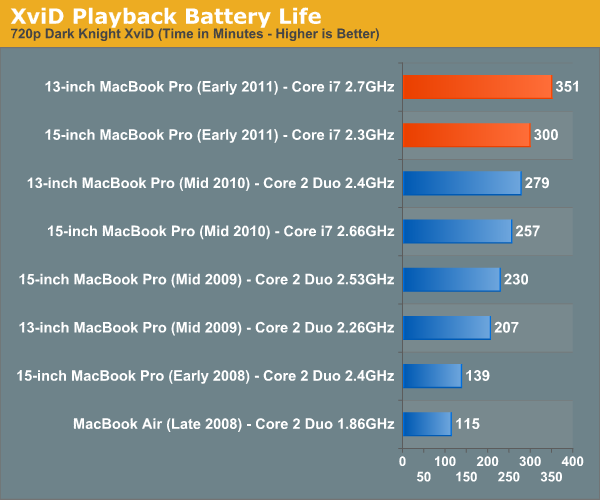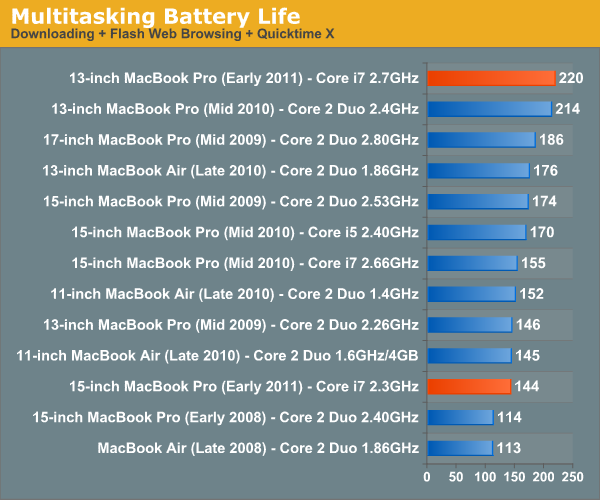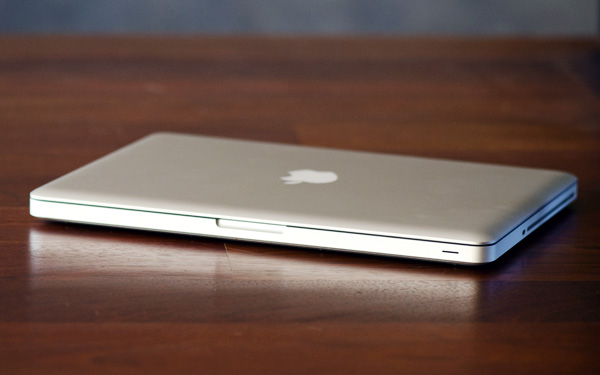The MacBook Pro Review (13 & 15-inch): 2011 Brings Sandy Bridge
by Anand Lal Shimpi, Brian Klug & Vivek Gowri on March 10, 2011 4:17 PM EST- Posted in
- Laptops
- Mac
- Apple
- Intel
- MacBook Pro
- Sandy Bridge
Battery Life
With the potential for higher power draw, battery life on these new systems has the chance to be really, really bad. In reality it breaks down like this: light usage cases are equal if not better than last year's model. Apple makes up for the higher core count of the 15-inch MBP by capping turbo speeds and being very good about allowing the CPU to go into deep sleep states under OS X. On top of that, Sandy Bridge is a very efficient microarchitecture that manages to get work done quicker than Arrandale and get to sleep faster.
Heavy usage cases however can easily be worse than last year's model, specifically with the 15 and 17-inch systems. The new 13 is a mixed bag. Core 2 was a pretty low power architecture, beating its battery life will be difficult. The only scenario our battery life tests don't duplicate is one where workload scales with performance. Right now all of our tests are fixed workloads: web pages may render quicker, but you'll still be idle for the same amount of time regardless of system. Video frames may decode quicker, but they'll still play back at the same 24 fps. If you use the additional performance of these systems to do more then you'll likely see even worse battery life (see the power numbers on the previous page).
Light Web Browsing
Here we're simply listing to MP3s in iTunes on repeat while browsing through a series of webpages with no flash on them. Each page forwards on to the next in the series after 20 seconds.
The display is kept at 50% brightness, all screen savers are disabled, but the hard drive is allowed to go to sleep if there's no disk activity. The wireless connection is enabled and connected to a local access point less than 20 feet away. This test represents the longest battery life you can achieve on the platform while doing minimal work. The results here are comparable to what you'd see typing a document in TextEdit or reading documents.

For the 15-inch model battery life has doubled since 2008. Even compared to last year's model Apple has actually improved idle/light usage battery life by 8%. With 9 hours of battery life I can confirm that if you're just using the 15-inch MBP as a glorified typewriter this is what you'll see. It's a great combination of a system that has performance on tap but the battery life to last you if you just need to do some writing.
The 13-inch MacBook Pro actually takes a step back compared to last year's model but it's still the Mac with the 3rd longest battery life.
Boot Camp Battery Life
Under Windows 7 there's no option to use the iGPU, the 15 and 17-inch MacBook Pros default to their dGPU. As we already showed, simply enabling the dGPU hurts battery life. What about the move to Windows 7 on top of that? To find out I ran our light web browsing battery life test under Windows 7. I subbed in IE8 and Windows Media Player for Safari and iTunes and otherwise ran with similar settings as our Mac test:

Compared to OS X with the dGPU enabled, Windows 7 delivers 20% lower battery life. The bigger penalty however is the forced dGPU usage under Windows. If you're planning on using the new 15-inch MBP as a Windows notebook, don't expect to get anywhere near the battery life that is promised under OS X.
Flash Web Browsing
The test here has three Safari windows open, each browsing a set of web pages with between 1—4 animated flash ads per page, at the same time. Each page forwards onto the next after about 20 seconds.
As always, the display is set to 50% brightness, audio at two bars, screensaver disabled and the hard drive is allowed to go to sleep if idle. The wireless connection is enabled and connected to a local access point less than 20 feet away.

Turn Flash on and up the intensity of the workload and the numbers get a lot more reasonable. The new 15-inch MacBook Pro leads the pack with 7 hours of battery life. You'll note that this is exactly what Apple promises on its website. At 7 hours this is also a 20% improvement over last year's model. Other than OS/optimization differences the only explanation I have here is that Sandy Bridge provides a sufficient enough increase in CPU performance to render a page and flash ads get to sleep quicker compared to Arrandale. Another contributing factor is the new 32nm iGPU which is active full-time under Safari. The GPU alone is probably a bit more efficient at rendering flash than last year's GeForce GT 330M.
The 13-inch model actually equals its predecessor. I suspect the Core 2 Duo is still a lower power CPU under a moderate load.
XviD Video Playback
I ripped The Dark Knight to XviD and played it back continuously in QuickTime X with Perian installed. For this test the display was set to full brightess and audio was set at two bars below maximum. Once more the hard drive was allowed to go to sleep if it was idle. The AirPort (wireless LAN) was enabled and connected to a local access point less than 20 feet away.

Multitasking Battery Life
Our final battery life test is the worst case scenario. In this test we have three open Safari windows, each browsing a set of web pages with between 1—4 flash ads per page, at the same time. We're also playing an XviD video in a window all while downloading files from a server at approximately 500KB/s.

I mentioned earlier that the new 15-inch MBP has the potential to have much worse battery life given that it has twice the cores of its predecessor. Our multitasking battery life test gives you a little indication of that. At 144 minutes the new 15 lasts just under 2.5 hours here. It's only a slight reduction compared to last year's model but that's only because the workload isn't scaled up at all. OS X is likely scheduling work here across all four cores rather than just two in last year's model, driving up power consumption and decreasing battery life ever so slightly.
The new 13-inch on the other hand is pretty sweet. At 3.66 hours it's the new king of our multitasking battery life test, and it's even a slight improvement compared to the 2010 version.
Just playing back movies on the new SNB notebooks is an improvement on both models. The new 15 manages 5 hours while the new 13 is good for almost 6 hours of battery life.
Overall I'd say the battery life story of the new MacBook Pros is a mixed bag. Under light to moderate workloads the 15-inch will likely do better than the 2010 15-inch MBP, while the 13-inch is roughly the same as its predecessor. It's only under heavy use that the new 15-inch will actually do worse than last year's model. You will have to keep an eye on what you're doing with the machine because the new 15-inch MBP has the ability to use a lot more power than last year's model. The bigger issue actually has to do with the dGPU. If you use Chrome or any of the other applications that will trigger the dGPU to turn on, kiss your battery life goodbye. Even light usage suffers if your discrete GPU is active.
The new 13 is a bit less finicky. It's either going to offer you similar or better battery life than last year's model.











198 Comments
View All Comments
zappb - Saturday, March 12, 2011 - link
Give me a mac book pro with windows 7 as a base install, and id be all over it.Mac OS sucks ass, don't know how anyone can make any money using it. Windows or ill stick to lenovo, would rather send my hard earned dollars to apple but as it stands, not a chance.
bymi - Saturday, March 12, 2011 - link
Hi,thanks for the great review of the new MacBooks!
I googled a lot, but was not able to find a working copy of the MSR Tools used in his article.
Sorry if this hat been discussed before, but i didn't find anything using the search funtionality here.
So where can i get these MSR Tools?
Thank you everybody for a link.
Best
bymi
Ryan Smith - Sunday, March 13, 2011 - link
http://www.insanelymac.com/forum/index.php?showtop...Note that it only works with Snow Leopard booted up in to 32bit mode, as the driver needed to read the MSRs is 32bit.
philipus - Saturday, March 12, 2011 - link
Does anyone know the approximate battery life when using Photoshop (I have CS5) with the dGPU enabled vs disabled?What is the approximate performance drop in Photoshop when not using the dGPU?
These are my main questions before deciding to get the 15" MBP.
Thanks for any insight.
/p
http://philipus.com
fcarnival - Sunday, March 13, 2011 - link
Hello Anandtech, thanks for the Apple's revenue breakdown. Could you also post the profit breakdown of Apple's products? I would like to know which device brings the most profit to Apple. Thanks!macfanpro - Monday, March 14, 2011 - link
I am very curious about this as well - with the tablet market supposedly tripling this year, I want to know what the ramifications are for earnings.Apple has a very nice page with related data (http://www.apple.com/investor/), but alas, I don't think they provide earnings breakdown by product (it's not in their detailed 70+ page annual report)...
amanrai - Monday, March 14, 2011 - link
could you confirm, definitively, whether or not the thunderbolt port will be able to support a discrete pci e based graphics card with or without a HDMI combination?thank you for all of your reviews. they are incredibly detailed and very helpful.
macfanpro - Monday, March 14, 2011 - link
Thanks so much for such an insightful review! I'm trying to rationalize buying a MBP, and I have two questions:Question about power draw) The MBP comes with a 85W adapter, but its maximum power draw is 93.2W. Could this lead to throttling/maximum performance not being achieved even when one is on the adapter?
Question about turbo boost) Some people have reported the turbo boost (for the i7 MBP 13) not working in Boot Camp. (Link: http://www.pcpro.co.uk/blogs/2011/03/10/apple-macb... Do you have any more news on this front?
anaboo - Monday, March 14, 2011 - link
Strong article - appreciate the in depth of benchmarks and insight.I'm hoping you guys can run the same set of in-depth Windows gaming benchmarks on the 15-inch MBP (particularly for the radeon gfx card). Curious to whether there is sub-optimal performance against a similar set of comparables (2010 MBPs, the Mac versions of these games, etc.).
Thanks!
davidglennbailey - Wednesday, March 16, 2011 - link
Best article on the internet on the new Macbook Pros. I'm ordering a 17" Macbook Pro on Friday. Here are my issues.1. Just take the cheap SATA hard drive now and upgrade to a fast SSD in the future when the prices fall a little farther? I will probably void a warranty? How difficult is the process to change one of those out and my chances of screwing something up? How do they even connect inside the machine and how reliable is it?
2. I can understand increased functionality spread out over the life of a product, but even at 3+ years is the .1ghz for 250$ ever worth it? Maybe for the increased cache or any other features?
3. Upgrading the memory was a breeze last time and shouldn't be an issue. Would there be any point or would it be even possible to go above 1333mhz or 8 gigs?
Just to add my 2 cents into the debate. I've had this Macbook Pro for about 5 years. I've put it through hell and back. Sometimes, you just wind up getting what you pay for. Great time to buy if you've been waiting for the quad cores for a while.